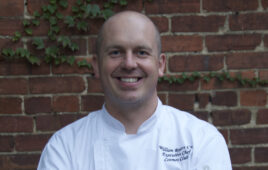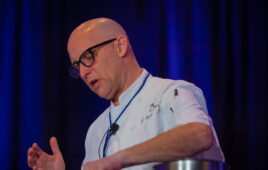 The dynamic between Robert Iannaccone, Executive Chef of Rehoboth Beach (Del.) Country Club (RBCC), and Clubhouse Manager Carpiu “C” Chereches is the stuff of legend.
The dynamic between Robert Iannaccone, Executive Chef of Rehoboth Beach (Del.) Country Club (RBCC), and Clubhouse Manager Carpiu “C” Chereches is the stuff of legend.
Iannaccone came to RBCC in 2014 after ten years as Executive Chef of Brookside Country Club, Macungie, Pa. (see “Straight Line to Success,” C&RB, December 2012). When he arrived, he was tasked with defining the club’s culinary identity and creating consistency within the operation—two huge tasks that he’s well on his way to achieving.
Chereches, who has been with the club since 2007 and was deeply involved in the process that led to Iannaccone’s hiring, has spent the same period of time supporting and encouraging his new Executive Chef at every opportunity, while simultaneously working toward his own sommelier certification, which he recently earned this summer.
The relationship between the two managers has been a pivotal part of RBCC’s turnaround. They share a nearly identical work ethic and passion for the operation. Where one is weak, the other is strong—and vice versa.
And as a result of their collaborations, RBCC has increased F&B sales by nearly $200,000 since 2013.
C2C: C, you were very involved in the interviewing and hiring process for a new chef. What stood out to you about Chef Iannaccone?
CC: We were looking for someone to take the club to the next level; we wanted to establish a culinary identity. When I met Chef, my first thought was, ‘I can see myself working really well with him.’ We are about the same age and we shared a lot of similar characteristics. Turns out, I was right; we work together really well.
C2C: What characteristics do you share?
CC: We both have the same outlook on the importance of food and beverage in a club. We’re in touch with new trends and we’re always looking for ways to keep the club vibrant, while respecting its traditions and culture.
C2C: What impressed you from the start about Chef?
CC: We would meet often and Chef would always take a lot of notes. He tries to be one step ahead and anticipate the members’ needs before they even know they need them. This has given me a much-needed sense of peace, knowing that he is guiding the operation.
C2C: How did you introduce him to members?
CS: The interview process was the first step, because ten members led it. Then, once he hit the ground running, we had a big party and we made sure he was out on the floor as often as possible, talking with members and learning their preferences. This helped him to get a feel for the pulse of the operation.
C2C: What was F&B like before Chef Iannaccone came on board?
CC: We were never known as a destination for dining. Members would typically eat here to meet their minimums. But since Chef has been here, and we’ve worked hard on both the culinary side and the service side, we’ve transformed the club. We’re busy every night we’re open. We’ve put our name back on the map. Now, we’re not only a destination for our amenities, but we’re a dining destination, too. We have members eating lunch and dinner with us daily. The change has been striking—and very, very exciting.
C2C: Chef, was it difficult for you to get your arms around RBCC’s operation?
RI: It took a little longer than I anticipated, but C was a huge asset during that time. We have 800 members, and I’m pretty sure he knows 799 of them by name. Anytime I have a question or an idea, he’s my sounding board, because he knows the membership best.
C2C: What has been your biggest success at the club so far?
RI: When I first started, C and I sat down and went through the calendar day by day, so I knew when we’d be busy and when it would be slow. He told me that Sunday nights were one of our slowest days, with only 40 covers at most. We both wanted to change that. So we started doing Sunday cookouts with a big grill, and now we’re doing 120 to 140 covers each week. It’s been a huge success with members—so much so that we have some making a standing reservation for parties of 8 to 10 each week, and then they actually show up.
CC: Chef managed to make a liar out of me. Sunday is now one of our busiest days.
C2C: Beyond Sundays, you’ve increased sales across the board pretty significantly. How?
RI: We didn’t raise prices; instead, we got smarter about our menus and our purchasing. We feature 10 to 12 items regularly, with constantly changing specials. This allows us to have better control of inventory and food costs, while still providing a lot of variety and very high-quality cuisine.
CC: Consistency has been really important. Staff training, too. Members have come to expect a good meal and good service each time they come to the club.
C2C: Tell me about the training program you just completed for your service staff.
CC: Chef and I noticed that the servers weren’t as familiar with a lot of basic culinary terms, which prevented them from explaining certain menu items. Chef and I decided to do a basic culinary class for them. There were three sessions and in the classes, Chef covered culinary terms, techniques and ingredients. We also went through wine/beer/liquor training with them.
C2C: The impact of the classes was substantial, wasn’t it?
CC: Sales are up 20% because of our commitment to continuing education.
C2C: C, you just earned your sommelier certification. Why was this important to you and to the club?
CC: I’ve always been passionate about wine. I also love to take on new challenges. It has been great for the membership to know they have someone to ask questions about wine and that our list is being written thoughtfully with their preferences in mind.
C2C: Have you seen a spike in sales?
CC: Before, we would never be able to sell a bottle of wine that cost a couple of hundred dollars. Now, we sell them regularly.
C2C: C, you’ve tapped into bringing seasonal FOH workers to the club from Romania and other
countries. How do you make sure they work seamlessly within the operation?
CC: We’ve found that younger Europeans are looking to broaden their portfolios and try their skills in the U.S. By coming here, we’re getting professionals who are eager to show their talent and they give us 100%.
C2C: Have there been challenges?
CC: Sometimes their 100% still doesn’t match up with a “seasoned” local professional who knows the ins and outs of an operation. There can be cultural challenges, too, like their accent might be very heavy or hard to understand. Sometimes they’re very entrepreneurial, too, and we lose them after a couple seasons. Even so, I can say for sure that they are or were a part of the team that got the club to where it is today.
C2C: C, what do you now value most in Chef Iannaccone?
CC: His patience. He sees where we’re going and he recognizes that we can’t make major changes overnight and still keep the trust of the membership. It has to be slow and thoughtful and methodic. And he works diligently, knowing that we’ll get there.
C2C: Chef, what do you value most in C?
RI: His support and constant feedback and the fact that we share the same work ethic and drive. For example, I’ll tell C that I’m taking Monday off, and he’ll say he is as well. Then I’ll end up at my desk, catching up on paperwork, and he’ll see my light on and stick his head in and ask why I’m there.
C2C: What do you say?
RI: I ask him the same thing.


